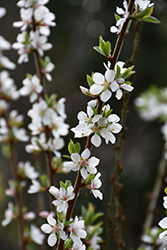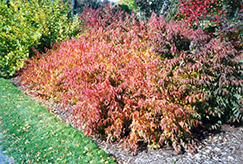Johnson Brothers Plant Finder
Height: 5 feet
Spread: 5 feet
Sunlight:
![]()
Hardiness Zone: 4a
Other Names: Flowering Almond, Korean Bush Cherry
Description:
A medium-sized ornamental shrub featuring showy white flowers with a pink blush, followed by tart cherries in summer, good for jams; low growing and wide spreading; very hardy and adaptable
Ornamental Features
Japanese Bush Cherry is draped in stunning fragrant white flowers with shell pink overtones along the branches in mid spring before the leaves. It has green deciduous foliage. The pointy leaves turn an outstanding orange in the fall. The fruits are showy red drupes displayed in mid summer.
This plant is primarily grown as an ornamental, but it's also valued for its edible qualities. The round sour fruit is most often used in the following ways:
- Cooking
- Preserves
Landscape Attributes
Japanese Bush Cherry is a multi-stemmed deciduous shrub with a more or less rounded form. Its relatively fine texture sets it apart from other landscape plants with less refined foliage.
This is a relatively low maintenance shrub, and is best pruned in late winter once the threat of extreme cold has passed. It is a good choice for attracting birds to your yard. It has no significant negative characteristics.
Japanese Bush Cherry is recommended for the following landscape applications;
- Mass Planting
- General Garden Use
- Orchard/Edible Landscaping
Planting & Growing
Japanese Bush Cherry will grow to be about 5 feet tall at maturity, with a spread of 5 feet. It tends to fill out right to the ground and therefore doesn't necessarily require facer plants in front, and is suitable for planting under power lines. It grows at a medium rate, and under ideal conditions can be expected to live for approximately 20 years. This is a self-pollinating variety, so it doesn't require a second plant nearby to set fruit.
This shrub should only be grown in full sunlight. It does best in average to evenly moist conditions, but will not tolerate standing water. It is not particular as to soil type or pH. It is highly tolerant of urban pollution and will even thrive in inner city environments. This species is not originally from North America.


